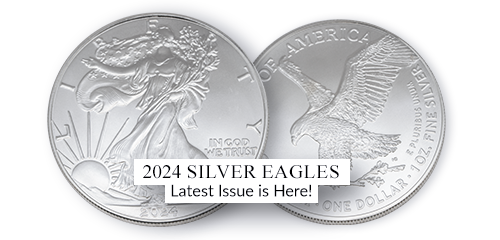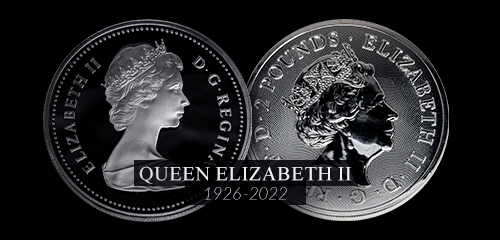|
Attribute - characteristics of a coin, for example, country of issue, inscription, date, metal composition, design, mint marks American Eagle Bullion Coin - platinum, silver and gold coins released by the United States Mint beginning in October 1986. American Numismatic Association (ANA) - nonprofit educational organization that encourages the study of money throughout the world
Bag Mark - a mark on a coin from contact with other coins in a mint bag. Blank - another word for planchet, the blank piece of metal on which a coin design is stamped.
Business
strike -
a coin
produced for general circulation (as opposed to a proof or uncirculated coin
specially made for collectors).
Brilliant - a coin
that is bright and shiny with a chrome luster
Bullion
-
platinum, gold
or silver in the form of bars or other storage shapes, including coins and
ingots
Cameo - a coin
with brilliant fields surrounding frosted design elements
Carbon Spots - small
spots of corrosion usually seen on copper coins
Clad Coinage - coins that have a core and outer layer made of different non-precious metals. Since 1965, all circulating U.S. dimes, quarters, half dollars and dollars have been clad.
Coin
-
flat piece of
metal issued by the government as money.
Coin Press - the
machine that makes a coin
Commemorative - a
special coin that honors the anniversary of a person, place, or event
Counterfeit - a fake coin or other piece of currency made so that people will think it's genuine. Currency - any kind of money - coins or paper money - that's used as a medium of exchange.
Deep Cameo - a cameo
coin with heavy contrast between the frosted and brilliant areas
Denomination
-
the different
values of money. U.S. coins currently are made in the following six
denominations: cent, nickel, dime, quarter, half dollar and dollar
Die(s) - The
plate press
used
to make coins upon which the designs are engraved and pressed
Edge
-
the outer
border of a coin, considered the "third side" (not to be confused
with "rim"). Some coins feature lettering, reeding, or
ornamental designs on their edges
Engraver - the
person who engraves the design of a coin onto the die
Error - an improperly produced coin, that was
overlooked in production, and later released into circulation
Eye Appeal - the
total visual aspects of a coin
Field - the flat
areas surrounding the raised design elements on a coin
Frosting - a
textured, almost crystalline, surface usually seen on the raised portions of
proof coins
Grading - the art
of determining the condition or quality of a coin
Hairline Scratch - a fine scratch on the surface of a coin usually caused by wiping with a cloth
Incuse
-
opposite of
relief, the part of a coin's design that is pressed into the surface
Key
Date -
a scarce
date required to complete a collection, usually more difficult to find and
afford
Matte - a fine, granular texture on the surface of a proof coin. Matte surfaces have a dull appearance as opposed to the reflective surfaces of a brilliant proof - featured on the Satin Finish Specimens
Medal
-
a metal object
resembling a coin issued to recognize an event, place, person or group, with no
stated value and not intended to circulate as money
Mint - A) the
Government Branch where coins are printed, B) Uncirculated (brand new), or C)
the act of making a coin
Mint
Luster -
the
dull, frosty, or satiny shine found on uncirculated coins
Mint Mark Set - A set consisting
of one example of each mint mark of a coin type (for example, a Morgan Dollar
Mint Mark Set would have one Morgan each from the Denver, San Francisco, New
Orleans, and Carson City Mints)
Mint Set -
official, government-issued sets of Uncirculated United States coins, first
issued in 1947
Motto
-
a word,
sentence or phrase inscribed on a coin to express a guiding national
principle. For example, "E Pluribus Unum" inscribed on all U.S.
circulating coins is Latin for "out of many, one."
MS -
abbreviation for a mint state coin
Numismatics - the
study and collecting of coins
Obsolete
-
a coin design
or type that is no longer produced
Obverse - the
front of a coin
Off-Center
-
describes a
coin that has received misaligned strike from the coin press and has portions
of its design missing
Oxidation - the
chemical reaction of metal with its surroundings; on copper coins, oxidation
shows up as carbon spots and a mellowing of the original color; on silver
coins, oxidation shows up as tarnish or toning
Pattern
-
an
experimental or trial piece, generally of a new design or metal
Planchet - the
blank disk that becomes a coin once it is stamped by the dies
Proof - a coin
that is specially prepared using a highly polished planchet, highly polished
dies, and extra pressure in the coining press – issued solely for collectors
Proof Set - official
government-issued sets of proof United States coins, first publicly released in
1936
PR -
abbreviation for proof coin
Reverse - the back of a coin
Roll
-
coins packaged
by banks, dealers or the United States Mint. The number of coins in a
roll depends on the denomination: 50 cents, 40 nickels, 50 dimes, 40
quarters, 20 half dollars, or 25 dollars
Series - a collection of coins that contains all date and mint marks of a specific design and denomination. For example, a Kennedy series would include a Kennedy half dollar from each year from each Mint facility (Philadelphia, Denver, San Francisco), beginning with the coins first issued in 1964
Slab
-
nickname for
some protective coin encapsulation methods, especially those that are
permanently sealed and rectangular
Special Mint Set - special
sets featuring a brand new finish of Uncirculated coins issued from 1965 to
1967 as replacements for both Mint Sets and Proof Sets (both of which were not
issued during those years)
Specimen - a
specially prepared coin, usually for presentation purposes or for sale to
collectors featuring a Satin Finish
Strike - A) the
stamping of a coin or B) the degree of detailing on a coin
Surfaces - the
outer layer of a coin including the raised portions of a coin and the edge
Toning -
oxidizing of the surface of a coin caused by a chemical reaction between the
metal of the coin and its surroundings, usually the case or bag holding it
Type Set – A set consisting of one example each denomination of each design in each denomination of a coin type (for example, a Nickel Type set would include a Shield Nickel, Liberty Nickel, Buffalo Nickel, Jefferson Nickel, and each Westward Journey Nickel)
Uncirculated - A) a
coin that has not circulated or B) the condition or “grade” given to coins of
the highest quality
Variety - something
different from the standard type. In
Morgan Dollars, these are known as VAMs
Year/Date Set – A set consisting of one example of each date of a coin type (for example, a State Quarter Year/Date Set would have one Quarter from each year between 1999-2008, making it a 10 coin set) |


